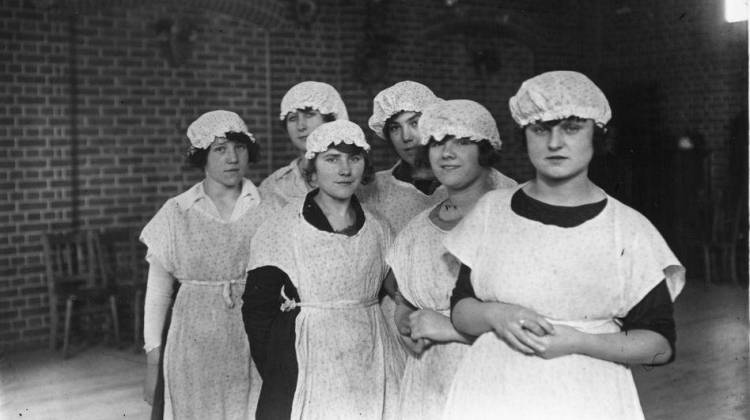Many Americans were introduced to the world of early 20th century British servants through the PBS series Downton Abbey, which premieres its fourth season Sunday. The show is set in an era when domestic service was the largest single occupation in Great Britain.
"In 1900, it was calculated to comprise a third of all women who were in the workforce," writer Lucy Lethbridge tells Fresh Air's Dave Davies.
In Servants: A Downstairs History of Britain from the Nineteenth Century to Modern Times, Lethbridge looks at the service industry through the diaries, letters and memoirs of servants. She explores the worlds of estates, which employed dozens of servants, as well as more modest homes that might have one or two servants, and even poorer families who employed part-time domestic help. Her book chronicles the evolution of service through the social changes of the 20th century, and the tension between servants and other working-class Brits.
Interview Highlights
On the British attitude toward service
The British had a very profound sense of the idea of a sort of social pyramid, a kind of noblesse oblige, and this filtered right down through the middle classes — that those who could afford to had a sort of duty of care to the working class.
It was a form of retaining social order, and I think you see it demonstrated very clearly in the British reluctance to take up new technologies in the home. They were far slower in taking up these technologies than families on the [European] continent, and certainly in America, because the idea of having people in the house, living with you, doing this work was so deeply rooted in the national psyche that it seemed vulgar to have a washing machine when you could employ two girls to do your washing.
On the role of the butler
I read a lot of butlers' memoirs, and what I found particularly fascinating was how [they] revealed how butlers were so butlery. ... Indeed a lot of ... men in service at the higher level colluded in their own caricature. And, of course, they themselves were echoing the prevailing view of what it was to be a gentleman. The butler is, as it were, a sort of echo chamber of the upstairs. In the servant's hall he is king, as the master of the house is king upstairs. ...
I think the caricature is someone who is rather pedantic, rather gloomy, very serious, extremely conservative, who echoes the conservative values of his master but is often ... a Jeeves figure, is often also rather more intelligent. That is the other caricature, which is a very old one: the clever manservant and the silly ... master. ... This is a role which butlers have appeared to play to the hilt. ...
Certainly in the first part of the 20th century, the butler is a very anachronistic figure at a time where working-class men were increasingly politically active. The labor party had made it not impossible to imagine ... say, a miner ... or a trade union official or a factory worker becoming an MP [member of Parliament] and then possibly, after the war, going into the House of Lords. That is impossible to imagine for a butler ... because there was something about service that stuck people with an identity. It wasn't just a job; it was a whole identity. And it was a reason why their working-class peers often looked down on servants.
On the average workday of a maid
The most common servant of all is what we'd call a maid-of-all-work. So she did a bit of everything and she'd be up at 5:30 or 6 a.m. lighting all the fires in the house, and she probably wouldn't go to bed until after her employers had had their dinner and she'd then have to wash it up, so maybe 10.
The work was unbelievably hard and onerous; ... a half-day off a week and every other Sunday is usually the form, but you would be quite heavily curfewed. You'd be expected to come back certainly before 9 o'clock. So going out for the evening would be difficult because it would be curtailed. ...
These girls were on average about 13 or 14, and if they had come from very poor, particularly urban households, hideously undernourished, this was an incredibly long day. The average housemaid, it was calculated in the 1890s, carried three tons of water every week up and down stairs. They were tiny, these girls. ... If you look at photographs of them, they were little shrimps of girls.
On servants being both visible and invisible
Servants are in this rather curious position of being both required to be highly visible and completely invisible. The high visibility of a servant with an elaborate uniform opening the door is very much an indication of status. We use it all the time as a shorthand in films and television programs ... for grandeur.
At the same time, the wheels of the house were oiled and required to be run without any apparent effort at all. So if you passed a servant sweeping the stairs, she either had to turn her face to the wall or she nipped behind little doorways that were often ... on staircases or along corridors or back stairs, because her presence was almost an admission that the house didn't run itself.
9(MDEwMDc1MzM3MDEzNDczOTA0MDc1MzViMQ001))
 DONATE
DONATE










 Support WFYI. We can't do it without you.
Support WFYI. We can't do it without you.